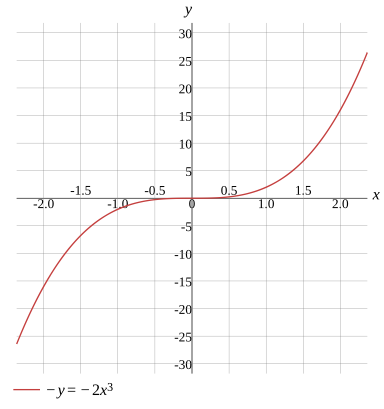Question
Function
Find the x-intercept/zero
Find the y-intercept
x=0
Evaluate
−y=−2x3
To find the x-intercept,set y=0
−1×0=−2x3
Any expression multiplied by 0 equals 0
0=−2x3
Swap the sides of the equation
−2x3=0
Change the signs on both sides of the equation
2x3=0
Rewrite the expression
x3=0
Solution
x=0
Show Solution

Solve the equation
Solve for x
Solve for y
x=234y
Evaluate
−y=−2x3
Swap the sides of the equation
−2x3=−y
Change the signs on both sides of the equation
2x3=y
Divide both sides
22x3=2y
Divide the numbers
x3=2y
Take the 3-th root on both sides of the equation
3x3=32y
Calculate
x=32y
Solution
More Steps


Evaluate
32y
To take a root of a fraction,take the root of the numerator and denominator separately
323y
Multiply by the Conjugate
32×3223y×322
Calculate
23y×322
Calculate
More Steps


Evaluate
3y×322
The product of roots with the same index is equal to the root of the product
3y×22
Calculate the product
322y
2322y
Calculate
234y
x=234y
Show Solution

Testing for symmetry
Testing for symmetry about the origin
Testing for symmetry about the x-axis
Testing for symmetry about the y-axis
Symmetry with respect to the origin
Evaluate
−y=−2x3
To test if the graph of −y=−2x3 is symmetry with respect to the origin,substitute -x for x and -y for y
−(−y)=−2(−x)3
Evaluate
y=−2(−x)3
Evaluate
More Steps


Evaluate
−2(−x)3
Rewrite the expression
−2(−x3)
Multiply the numbers
2x3
y=2x3
Solution
Symmetry with respect to the origin
Show Solution

Rewrite the equation
r=0r=2cos3(θ)sin(θ)r=−2cos3(θ)sin(θ)
Evaluate
−y=−2x3
Move the expression to the left side
−y+2x3=0
To convert the equation to polar coordinates,substitute x for rcos(θ) and y for rsin(θ)
−sin(θ)×r+2(cos(θ)×r)3=0
Factor the expression
2cos3(θ)×r3−sin(θ)×r=0
Factor the expression
r(2cos3(θ)×r2−sin(θ))=0
When the product of factors equals 0,at least one factor is 0
r=02cos3(θ)×r2−sin(θ)=0
Solution
More Steps


Factor the expression
2cos3(θ)×r2−sin(θ)=0
Subtract the terms
2cos3(θ)×r2−sin(θ)−(−sin(θ))=0−(−sin(θ))
Evaluate
2cos3(θ)×r2=sin(θ)
Divide the terms
r2=2cos3(θ)sin(θ)
Evaluate the power
r=±2cos3(θ)sin(θ)
Separate into possible cases
r=2cos3(θ)sin(θ)r=−2cos3(θ)sin(θ)
r=0r=2cos3(θ)sin(θ)r=−2cos3(θ)sin(θ)
Show Solution

Find the first derivative
Find the derivative with respect to x
Find the derivative with respect to y
dxdy=6x2
Calculate
−y=−2x3
Take the derivative of both sides
dxd(−y)=dxd(−2x3)
Calculate the derivative
More Steps


Evaluate
dxd(−y)
Use differentiation rules
dyd(−y)×dxdy
Evaluate the derivative
More Steps


Evaluate
dyd(−y)
Use differentiation rule dxd(cf(x))=c×dxd(f(x))
−dyd(y)
Use dxdxn=nxn−1 to find derivative
−1
−dxdy
−dxdy=dxd(−2x3)
Calculate the derivative
More Steps


Evaluate
dxd(−2x3)
Use differentiation rule dxd(cf(x))=c×dxd(f(x))
−2×dxd(x3)
Use dxdxn=nxn−1 to find derivative
−2×3x2
Multiply the terms
−6x2
−dxdy=−6x2
Solution
dxdy=6x2
Show Solution

Find the second derivative
Find the second derivative with respect to x
Find the second derivative with respect to y
dx2d2y=12x
Calculate
−y=−2x3
Take the derivative of both sides
dxd(−y)=dxd(−2x3)
Calculate the derivative
More Steps


Evaluate
dxd(−y)
Use differentiation rules
dyd(−y)×dxdy
Evaluate the derivative
More Steps


Evaluate
dyd(−y)
Use differentiation rule dxd(cf(x))=c×dxd(f(x))
−dyd(y)
Use dxdxn=nxn−1 to find derivative
−1
−dxdy
−dxdy=dxd(−2x3)
Calculate the derivative
More Steps


Evaluate
dxd(−2x3)
Use differentiation rule dxd(cf(x))=c×dxd(f(x))
−2×dxd(x3)
Use dxdxn=nxn−1 to find derivative
−2×3x2
Multiply the terms
−6x2
−dxdy=−6x2
Change the signs on both sides of the equation
dxdy=6x2
Take the derivative of both sides
dxd(dxdy)=dxd(6x2)
Calculate the derivative
dx2d2y=dxd(6x2)
Simplify
dx2d2y=6×dxd(x2)
Rewrite the expression
dx2d2y=6×2x
Solution
dx2d2y=12x
Show Solution

Graph
